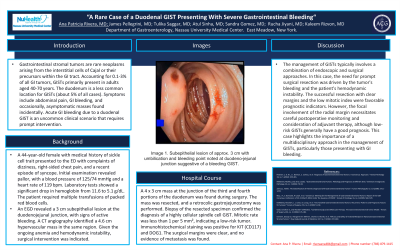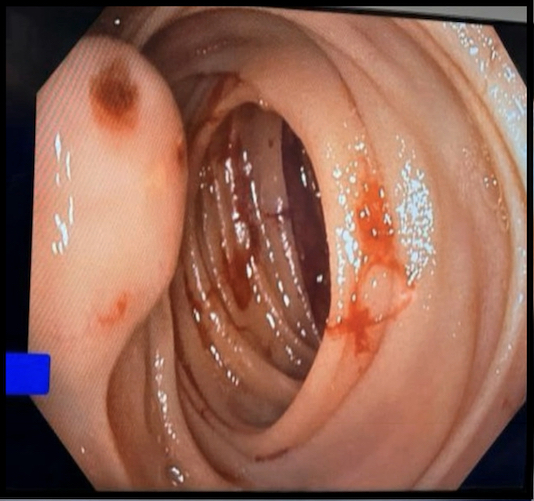Monday Poster Session
Category: Small Intestine
P3293 - A Rare Case of a Duodenal GIST Presenting With Severe Gastrointestinal Bleeding
Monday, October 28, 2024
10:30 AM - 4:00 PM ET
Location: Exhibit Hall E

Has Audio

Ana P. Rivera Arauz, MD
Nassau University Medical Center
Amityville, NY
Presenting Author(s)
Ana P. Rivera, MD1, James R. Pellegrini, MD2, Tulika Saggar, MD3, Atul Sinha, MD3, Sandra Gomez, MD3, Rucha Jiyani, MD3, Kaleem Rizvon, MD, FACG3
1Nassau University Medical Center, Amityville, NY; 2Nassau University Medical Center, Great River, NY; 3Nassau University Medical Center, East Meadow, NY
Introduction: Gastrointestinal stromal tumors are rare neoplasms arising from the interstitial cells of Cajal or their precursors within the GI tract. Accounting for 0.1-3% of all GI tumors, GISTs primarily present in adults aged 40-70 years. The duodenum is a less common location for GISTs (about 5% of all cases). Symptoms include abdominal pain, GI bleeding, and occasionally, asymptomatic masses found incidentally. Acute GI bleeding due to a duodenal GIST is an uncommon clinical scenario that requires prompt intervention.
Case Description/Methods: A 44-year-old female with medical history of sickle cell trait presented to the ED with complaints of dizziness, right-sided chest pain, and a recent episode of syncope. Initial examination revealed pallor, with a blood pressure of 125/74 mmHg and a heart rate of 119 bpm. Laboratory tests showed a significant drop in hemoglobin from 11.6 to 5.1 g/dL. The patient required multiple transfusions of packed red blood cells.
An EGD revealed a 3 cm subepithelial lesion at the duodenojejunal junction, with signs of active bleeding. A CT angiography identified a 4.6 cm hypervascular mass in the same region. Given the ongoing anemia and hemodynamic instability, surgical intervention was indicated.
Intraoperatively, a 4 x 3 cm mass at the junction of the third and fourth portions of the duodenum was confirmed. The mass was resected, and a retrocolic gastrojejunostomy was performed to restore gastrointestinal continuity. Histopathological examination of the resected specimen confirmed the diagnosis of a highly cellular spindle cell GIST. Mitotic rate was less than 1 per 5 mm², indicating a low-risk tumor. Immunohistochemical staining was positive for KIT (CD117) and DOG1, confirming the diagnosis. The surgical margins were clear, and no evidence of metastasis was found in the regional lymph nodes.
Discussion: The rarity of duodenal GISTs combined with their potential for acute presentation through severe gastrointestinal bleeding makes this case particularly noteworthy. Duodenal GISTs are prone to presenting with bleeding due to their mucosal involvement and high vascularity, posing diagnostic and therapeutic challenges. Managing bleeding GISTs typically involves a combination of endoscopic and surgical approaches. In this case, the need for prompt surgical resection was driven by the tumor's bleeding and the patient's hemodynamic instability. The successful resection with clear margins and the low mitotic index were favorable prognostic indicators.

Disclosures:
Ana P. Rivera, MD1, James R. Pellegrini, MD2, Tulika Saggar, MD3, Atul Sinha, MD3, Sandra Gomez, MD3, Rucha Jiyani, MD3, Kaleem Rizvon, MD, FACG3. P3293 - A Rare Case of a Duodenal GIST Presenting With Severe Gastrointestinal Bleeding, ACG 2024 Annual Scientific Meeting Abstracts. Philadelphia, PA: American College of Gastroenterology.
1Nassau University Medical Center, Amityville, NY; 2Nassau University Medical Center, Great River, NY; 3Nassau University Medical Center, East Meadow, NY
Introduction: Gastrointestinal stromal tumors are rare neoplasms arising from the interstitial cells of Cajal or their precursors within the GI tract. Accounting for 0.1-3% of all GI tumors, GISTs primarily present in adults aged 40-70 years. The duodenum is a less common location for GISTs (about 5% of all cases). Symptoms include abdominal pain, GI bleeding, and occasionally, asymptomatic masses found incidentally. Acute GI bleeding due to a duodenal GIST is an uncommon clinical scenario that requires prompt intervention.
Case Description/Methods: A 44-year-old female with medical history of sickle cell trait presented to the ED with complaints of dizziness, right-sided chest pain, and a recent episode of syncope. Initial examination revealed pallor, with a blood pressure of 125/74 mmHg and a heart rate of 119 bpm. Laboratory tests showed a significant drop in hemoglobin from 11.6 to 5.1 g/dL. The patient required multiple transfusions of packed red blood cells.
An EGD revealed a 3 cm subepithelial lesion at the duodenojejunal junction, with signs of active bleeding. A CT angiography identified a 4.6 cm hypervascular mass in the same region. Given the ongoing anemia and hemodynamic instability, surgical intervention was indicated.
Intraoperatively, a 4 x 3 cm mass at the junction of the third and fourth portions of the duodenum was confirmed. The mass was resected, and a retrocolic gastrojejunostomy was performed to restore gastrointestinal continuity. Histopathological examination of the resected specimen confirmed the diagnosis of a highly cellular spindle cell GIST. Mitotic rate was less than 1 per 5 mm², indicating a low-risk tumor. Immunohistochemical staining was positive for KIT (CD117) and DOG1, confirming the diagnosis. The surgical margins were clear, and no evidence of metastasis was found in the regional lymph nodes.
Discussion: The rarity of duodenal GISTs combined with their potential for acute presentation through severe gastrointestinal bleeding makes this case particularly noteworthy. Duodenal GISTs are prone to presenting with bleeding due to their mucosal involvement and high vascularity, posing diagnostic and therapeutic challenges. Managing bleeding GISTs typically involves a combination of endoscopic and surgical approaches. In this case, the need for prompt surgical resection was driven by the tumor's bleeding and the patient's hemodynamic instability. The successful resection with clear margins and the low mitotic index were favorable prognostic indicators.

Figure: Image 1. Subepithelial lesion of approx. 3 cm with umbilication and bleeding point noted at duodeno-jejunal junction suggestive of a bleeding GIST.
Disclosures:
Ana Rivera indicated no relevant financial relationships.
James Pellegrini indicated no relevant financial relationships.
Tulika Saggar indicated no relevant financial relationships.
Atul Sinha indicated no relevant financial relationships.
Sandra Gomez indicated no relevant financial relationships.
Rucha Jiyani indicated no relevant financial relationships.
Kaleem Rizvon indicated no relevant financial relationships.
Ana P. Rivera, MD1, James R. Pellegrini, MD2, Tulika Saggar, MD3, Atul Sinha, MD3, Sandra Gomez, MD3, Rucha Jiyani, MD3, Kaleem Rizvon, MD, FACG3. P3293 - A Rare Case of a Duodenal GIST Presenting With Severe Gastrointestinal Bleeding, ACG 2024 Annual Scientific Meeting Abstracts. Philadelphia, PA: American College of Gastroenterology.
